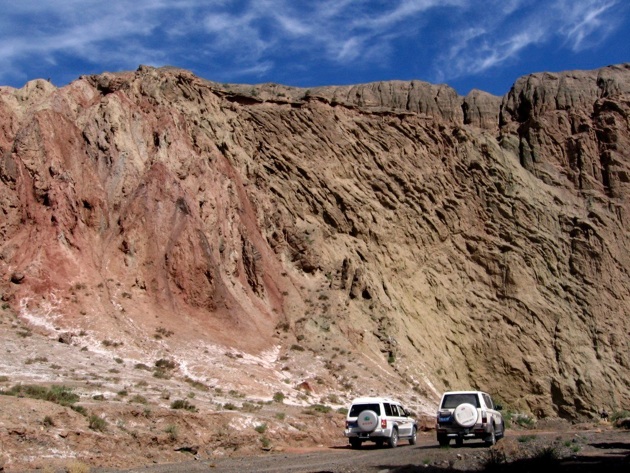Sub-vertically foliated gouge separating Jurassic from Cretaceous strata. Hei Shan
SUMMARY
The Altyn Tagh Fault (ATF) on the northern margin of the Tibetan Plateau is a key structural feature in all tectonic models of Asia. Mechanical models for strain within the Asian lithosphere largely fall into two end members: distributed crustal thickening and lateral extrusion. Geodetic and structural studies indicate that the northern margin of the Tibetan Plateau currently deforms via distributed crustal thickening, but piercing point studies suggest two distinct phases of slip on the ATF: fast, high-magnitude Late Oligocene-Early Miocene slip and slow, low magnitude post-Early Miocene slip. Piercing point studies near the Modern NE tip of the ATF, the Neogene shortening and cooling record of the Qilian Shan, and the slip history of faults within the Qilian Shan suggest that the >310 km of pre-Middle Miocene ATF displacement was transferred northeast into the Alxa block. Recent field mapping has revealed numerous NE-SW trending strike-slip faults showing large Cretaceous and minimal Neogene sinistral offsets. These structures may have been kinematically linked to the ATF. We are testing this hypothesis for strain partitioning in Central Asia with structural mapping, basin analysis, bedrock thermochronology, and paleomagnetism of mountain ranges in the northern Qilian Shan and throughout Alxa. Our goal is to determine the magnitude and timing of strike-slip deformation within these regions.
TEAM
-
Grant Rea-Downing (Utah), Brad Ritts (Chevron, UCSC), Brian Darby (ExxonMobil), Jeremy Hourigan (UCSC), Lauren Shumaker (Stanford), Matt Heumann (ConocoPhillips), Guangsheng Zhuang (Lancaster), Sam Johnstone (Stanford), Rob Coe (UCSC).
FUNDING
-
NSF Tectonics, INDEPTH IV
PUBLICATIONS and SELECTED PRESENTATIONS
-
Please see the Publications page.

Did the Altyn Tagh Fault continue beyond the northern margin of Tibet? Implications for strain partitioning during continent-continent collision


